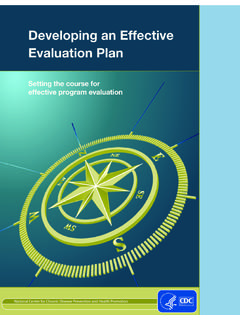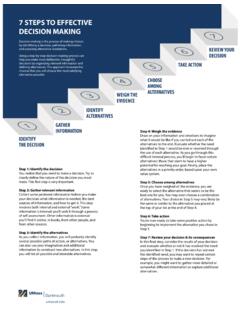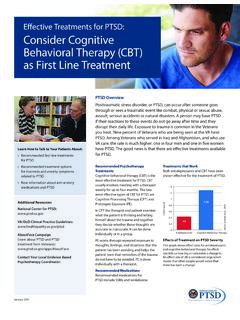Transcription of SEVEN ELEMENTS OF EFFECTIVE NEGOTIATIONS
1 SEVEN ELEMENTS OF EFFECTIVE NEGOTIATIONS December 2008 Jerome Slavik Adapted from Getting To Yes Negotiating Agreements Without Giving In, R. Fisher and W. Ury 1. RELATIONSHIP: AM I PREPARED TO DEAL WITH THE RELATIONSHIP? a) A good negotiating relationship is needed to address differences and conflicts. b) Separate people issues from substantive issues. c) Plan and prepare to build and maintain a good working relationship. d) Be respectful, trustworthy and unconditional constructive. 2. COMMUNICATION: AM I READY TO LISTEN AND TALK EFFECTIVELY? CREATING A LEARNING CONVERSATION a) Core Skills Basic Communication Skills in Negotiation i.
2 Active listening To do active listening, we must overcome some of our tendencies and habits that interfere with good listening. ii. Acknowledging what has been said and felt Have you effectively demonstrated to the other negotiators that you have heard and UNDERSTOOD what they have said? Use paraphrasing and summarizing. iii. Listen to understand, speak to be understood Have you thought about ways to communicate with the other party by using words (and at the right time) in a way that they will understand? iv. Speak about yourself, not them Have you let them know what are the crucial issues for you and your community and how you feel about the problem at hand?
3 Use I statements. v. Speak for a purpose Have you thought through the timing and impact of what you wish to say? Be clear and concise. b) Core Skills Communications to Gather Knowledge and Learn About Their Interests i. Clarifying and Probing Skills Have you thought about basic questions for clarification (including empathetic questions) you might ask to draw out the interests from the other negotiators? can you Could you use consequential questions to draw out the other side? what would you need HMS/HSDM/HSPH OMBUDS OFFICE Melissa Brodrick, Ombudsperson, 164 Longwood Avenue, Boston, Massachusetts 02115 617-432-4040 (Ombuds line) 617-432-4041 (office line) ii.
4 Integrative Framing Skills Paraphrasing Have you given feedback in your own words or what you understand the key concerns and interests on the other side to be? Summarizing Can you accurately draw together the main points of the discussion up to that point in time? 3. INTERESTS: WHAT DO PEOPLE REALLY WANT? a) Collectively identify and articulate the interests, concerns, and needs of all relevant parties (mine, yours, theirs). Remember: most parties do not know all their interests or necessarily agree on their interests. b) Identify and prioritize community interests together. Get on the same page. c) Probe for your and their unarticulated or underlying interests.
5 D) Share and clarify the respective interests of the parties. Move beyond speculation about to acknowledgement of their interests. e) Identify and share common interests as a basis to develop options. f) Interests from the agenda. 4. OPTIONS: WHAT ARE THE POSSIBLE AGREEMENTS OR BITS OF AN AGREEMENT? a) Design options, not positions. b) Create options to meet interests of both parties. c) Remember when designing options they also must transparently meet their interests. Find ways to maximize joint gains for both. 5. ALTERNATIVES: WHAT WILL I DO IF WE DO NOT AGREE? a) Do we need to negotiate or can we satisfactorily meet our interests in other ways?
6 B) Identify and articulate our best/doable alternatives to a negotiated agreement. c) Fully understand the implication, consequences, risks and costs of your and their BATNA. d) Select and improve our BATNA e) Identify the best and worst alternatives open to the other side. f) How can we make their BATNA worse for them? ( keep them at the table) 6. LEGITIMACY: WHAT CRITERIA WILL I USE TO PERSUADE EACH OF US THAT WE ARE NOT BEING RIPPED OFF? a) Fairness is a governing consideration. b) Use external criteria and objective standards as a basis to legitimize your preferred options and as a shield against unreasonable proposals from the other side.
7 C) Use demonstrable fairness of the process and outcome to persuade them of the merits of a proposal. d) Offer their negotiator an attractive way to explain his decision to his principals (see number 8). 7. COMMITMENT: WHAT COMMITMENTS SHOULD I SEEK OR MAKE? a) Get commitments at the end not the beginning. b) Identify all of the implementation issues to be included in the agreement. No post-argument surprises? c) Plan the timeframe and steps to implement the agreement. 8. CONCLUSION: WHAT IS A GOOD OUTCOME? a) Meets interests. b) Demonstrably fair. c) Better than BATNA. d) Doable. s:\jns-r\files\jerome\2008 neg. workshop\ SEVEN ELEMENTS of EFFECTIVE NEGOTIATIONS nov.
8














